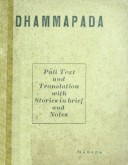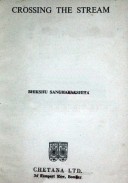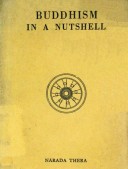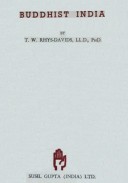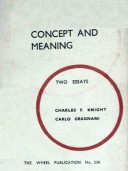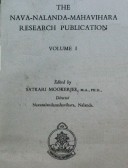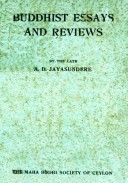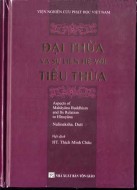Tìm Sách
Sách tiếng Anh-English >> Dhammapada
Thông tin tra cứu
- Tên sách : Dhammapada
- Tác giả : Narada Thera Vajirarama
- Dịch giả :
- Ngôn ngữ : Anh
- Số trang : 321
- Nhà xuất bản : Colombo
- Năm xuất bản : 1963
- Phân loại : Sách tiếng Anh-English
- MCB : 1210000003845
- OPAC :
- Tóm tắt :
Dhammapada (Pali text and translation with stories in brief and note)
PREFACE
Buddhism appeals both to the masses and to the intelligentsia. It offers milk for the babe and meat for the strong. It presents one way of life to the members of the Holy Order and another to the laity. Above all, it expounds a unique Path of Enlightenment.
All these characteristics are featured in the Dhammapada, one of the thirty-one books that comprise the Tipitaka, the three Baskets which contain the quintessence of the Buddha’s Teachings.
Any truth-seeker, irrespective of his religious beliefs, can read this book of Wisdom with interest and profit. By constantly reflecting on these golden sayings and by translating them into action in the course of one’s daily life, a religious – minded person can gain spiritual bliss that transcends worldly happiness and can attain to a higher spiritual plane whereby he can purify himself and try to purify and enlighten others both by example and by precept.
The Dhammapada is not a book to be read superficially like a novel and shelved aside. It should be read and re-read so that It may serve as a constant companion for inspiration, solace, and edification in times of need.
The Dhammapada was not preached by the Buddha in the present form. Three months after the Passing Away of the Buddha, the Arahats, who assembled at the First Convocation to rehearse the Teachings of the Buddha, collected some of the poetic utterances of the Buddha, which He expounded on different occasions, arranged and classified the treatise in its present form, naming it the Dhammapada.
The Pali term Dhamma, Samskrit Dharma is one of the most difficult words to be translated into English as it has many meanings. It has to be understood according to the context. Here it is used in the sense of Sayings or Teachings of the Buddha. Pada implies sections, portions, parts, or way. Dhammapada may-be rendered, «Sections or Portions of the Dhamma», «The Way of the Dhamma». It is somewhat difficult to offer a graceful English equivalent according to its literal meaning. «The Way of Truth», «The Way of Righteousness», «The Path of Virtue», are renderings that have been suggested by various scholars.
The Dhammapada consists of 423 melodious Pali verses, uttered by the Buddha on about 300 occasions, to suit the temperaments of the listeners in the course of His preaching tours during His ministry of forty-five years. Circumstances that led to these noble utterances are presented in the form of long or short stories, together with traditional interpretations of the Pali verses and technical terms, in the voluminous commentary written by Buddhaghosa. This valuable commentary has been ably translated by E. W. Burlinghame for the Harward Oriental Series. It may be remarked that most of these verses are better understood when read with the context.
The gems of truth embodied in these texts aptly illustrate the moral and philosophical Teachings of the Buddha.
The very first two stanzas briefly represent the ethico-philosophical system of the Buddha. The importance of the mind in assessing morality, the Buddhist law of moral causation (Kamma), the problem of pain and happiness, self-responsibility, etc., accompanied by two simple homely illustrations, find expression in these twin verses. The two relevant stories clarify the points at issue. The very first line of each of these twin verses presents some difficulty, especially the term Dhamma. Commentary gives a long interpretation. The two connected stories make the matter clear.
The verses dealing with hatred and its appeacement are of special significance in this atomic age. Force will certainly be met with force. Bombs will be met with bombs. Vengeance will be met with vengeance. Retaliation never leads to peace. Buddha’s advice to His non-violent followers is: Hatreds never cease through hatred, but through love alone they cease. Mettã or loving-kindness is the only answer to modern bombs.
The high ethical standard the Buddha expects from His ideal followers are depicted in some verses. The last two verses of the first chapter indicate the Buddha’s attitude towards mere learning and actual practice. The Dhamma is to be studied with the object of practising it. As such the Dhamma is compared to a raft whereby one crosses the ocean of Samsãra. The very last verse is alone sufficient for an ideal Bhikkhu for his whole lifetime. .
How the Buddha exercises His psychic powers to transform a.lust-ridden, mentally sick Bhikkbu to a pure, spiritually healthy individual is evident from the story of prince Nanda, His step-brother, and the verses uttered concerning him.
In obedience to the Buddha, though with reluctance, prince Nanda entered the Order on his wedding day. As he was constantly thingking of his bride-elect without being intent on the Holy life, the Buddha, instead of adopting the usual direct method of instruction, devised an effective practical way to divert his attention to a seemingly more desirable similar object and succeeded in making him an Arahat. See vv. 13-14.
The first two chapters mainly deal with the ethics of Buddhism and are of equal importance to both Bhikkhus and laymen.
The second chapter is a cogent answer to those critics who try to denounce Buddhism as (a dead hand). Appamãda, which denotes heedfulness, vigilance, earnestness, watchfulness and other allied meanings, is the name given to the second chapter.
It was the first verse on heedfulness occurring in this chapter that completely transformed the character of King Asoka the Righteous, who was originally stigmatised-Asoka the Wicked-owing to his atrocities perpetrated before his conversion to Buddhism.
At times a single verse like the foregoing, solitary line like «Seek no delight in worldly favours, but cultivate seclusion», or a pregnant word like «Strive» is alone sufficient for a whole lifetime.
The verse 24, which deals with causes that’ tend to worldly progress, shows that Buddhism is not absolutely other-worldly as some hasty critics are apt to think.
The third chapter is of special significance as it enables one to understand the Buddhist conception of the mind and the importance of mind control.
The chapter on Pleasures, Happiness, Hell, Evil, World, Flowers, the Fool, the Wise, Craving, etc. will prove very helpful to those who are engrossed in material pleasures. The illusive nature of worldly happiness and the kind of life one should lead in such a deluded world are shown in these chapters.
The chapters on the Buddha, the Arahat, the Brahmana will particularly appeal to those of a higher spiritual level. They depict the moral attitude of really enlightened beings.
One should not rest satisfied with a mere perusal of these golden sayings. They should be read, re-read, and pondered upon, together with the accompanying stories, drawing appropriate lessons therefrom. These interesting and edifying anecdotes clearly depict the greatness of the Buddha as an energetic, compassionate and wise Teacher, ever ready to serve all. All these noble utterances should be put into actual practice in the course of one’s daily life. Then only may one rightly say in the words of the Dhammapada: —
«Happily he lives who drinks of the Dhamma».
Readers will note the simplicity of the similes employed by the Buddha, which are intelligible even to a child. Take, for instance, the similes of the cart’s wheel, man’s shadow, the ill – thatched house, the sleeping village, clear deep lake, fragrant beautiful flower, a bee extracting honey, etc. The wisdom of the Buddha lies in His exposition of profound truths in such plain terms.
There is not a single verse in the Dhammapada that can be dismissed as unintelligible to a lay reader.
Direct teaching is the Buddha’s usual method of exposition. At times He exercises His psychic powers, not miracles, in order to enlighten His less Intelligent hearers or to give an actual demonstration to a concrete truth.
To a fisherman named Ariya, meaning noble whom He saw fishing, the Buddha said, “He is not an Ariya who is engaged in killing animals”. The man realized his ignoble act and later became a Noble in the strictest sense of the term.
In the Dhammapada there are several Instances to show that the Buddha preached not only to tbe intelligentsia but also to little children in their own” language. He was accessible, to all.
In preparing this translation I have consulted with profit the learned articles on the Dhammapada written by my revered teacher, the Venerable P.Siri Vajiranana Mahã Nãyaka Thera, the ancient Simhala translation, and almost all the available English translations. Special care was taken not to deviate from the traditional commentarial interpretations.
My first translation of the Dhammapada appeared in 1940, with a Foreword by Dr. Cassius A. Pereira (now Kassapa Thera). Later, Mahabodhi Society of India published two revised editions. Another revised edition was published in the Wisdom of the East Series in 1951 with a scholarly Introduction by Dr. E.J. Thomas, followed by a reprint in 1959. In this present latest edition several improvements have been made, copious notes have been added mainly for the benefit of those who are not acquainted with the fundamentals of the Dhamma, and relevant stories are given in brief in order to make the texts more intelligible to the readers.
I am grateful to Mr. S.W. Wijayatilaka, ex-Principal of Ananda college, Colombo, for carefully revising my manuscript and offering many valued suggestions.
My thanks are due to two of my Vietnamese pupils, Miss Le tbi Sanh (Jhãyĩ) and Miss Cao thi Cue (Citrã) for typing the manuscript.
Mr. Truong Dinh Dzu, a most distinguished Vietnamese Buddhist lawyer, former Rotary District- Governor of South-East Asia, needs a word of praise for so generously volunteering to defray the printing expenses of this Buddhist classic.
May this mun ficent act redound to his eternal bliss!
NÃRADA
Jelavana Vihãra,
Ky Vien Tu,
Saigon.
14th July, 1963.
CONTENTS
The Pali Alphabet
Preface
- Yamaka Vagga – The Twin Verses
- Appamada Vagga – Heedfulness
- Citta Vagaa – Mind
- Puppha Vagga – Flowers
- Bala Vagga – Fools
- Pandita Vagga – The Wise
- Arahanta Vagga – The Worthy
- Sahassa Vagga – Thousands
- Papa Vagga – Evil
- Danda Vagga – The Rod or Punishment
- Jara Vagga – Old Age
- Atta Vagga – The Self
- Loka Vagqa – The World
- Buddha Vagga – The Buddha
- Sukha Vagga – Happiness
- Piya yagga – Affection
- Kodha Vagga – Anger
- Mala Vagga – Impurities or Taints
- Dhamatịha Vagga – The Just or The Righteous
- Magga Vagga – The Way or The Path
- Pakinnaka Vagga – Miscellaneous
- Niraỹã Vagga – Woeful State
- Naga Vagga – The Elephant
- Tanhã Vagga – Craving
- Bhikkhu Yagga – The Bhikkhu or the Mendicant
- Brãhmana Vagga – The Brahmana
- Index
 Facebook
Facebook
 Google
Google
 Google+
Google+
